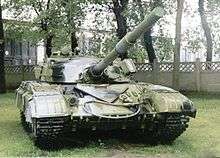Combination K

Combination K was a type of composite armor.
History
Combination K was fitted onto the Soviet T-64A.
The mix
Combination K is a three-layer composite armor consisting of outer and inner layer of steel and middle layer of glass-reinforced plastic ("steklotekstolit") and a pack of ceramic (allegedly corundum) plates.
The T-72 tanks have their gun turret frontal armour composed of three layers: outer and inner layers of steel and middle layer of sand or quartz ("kvartz", probably the origin of the "K" in the name; also implies some relationship between the T-64A and the kvartz composite). The gun turrets are cast with internal cavities on each side of the main gun, which are later filled with the desired composite material. Some Russian sources describe the material as "peschannye sterzhni" ("sand rods" or more likely "sandbars"), likely made of a form of silica similar to fused silica developed in the USA for the T95 prototype medium tanks in the 1952 program for equipping tanks with protection against shaped charges and HEAT rounds without sacrificing protection against kinetic energy penetrators. The same design of cast-steel turret with cavities for composite insets is reportedly used also in the more modern T-80 and T-90 tanks.[1] More modern T-90A model, with its object 187-derived slab-sided welded turret, offers an easier and more optimal way to mount the ceramic inserts, leading to the radically increased protection. Reportedly, during the Second Chechen War no T-90A suffered a penetrating hit, with some allegedly surviving up to seven RPG-7 hits that failed to penetrate its armor.